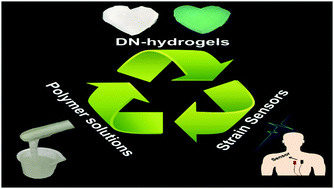Recyclable, stretchable and conductive double network hydrogels towards flexible strain sensors†
Abstract
Stretchable and elastic double network (DN) hydrogels are increasingly investigated for flexible electronics but their recyclability is rarely considered. Herein, recyclable, stretchable and conductive DN-hydrogels are explored and utilized in flexible resistive-type strain sensors. Such DN-hydrogels are fully physically cross-linked and composed of a crystalline domain cross-linked poly(vinyl alcohol) (PVA) network and a Tb3+-cross-linked poly(acrylic acid sodium) (PAANa–Tb3+) network. Due to their unique structure, DN-hydrogels have excellent recyclability and flexibility, and they are also conductive and photoluminescent due to the presence of Tb3+. Utilizing DN-hydrogels, flexible strain sensors are assembled and further applied to monitor large human motions, such as moving of two hands and bending of joints, as well as subtle physiological activities including moving of the bicipital muscle, swallowing and breathing. Overall, the present example not only helps to understand the toughening and strengthening mechanism of fully physically cross-linked DN-hydrogels, but also offers a clue to develop multifunctional hydrogels for recyclable flexible electronics.



 Please wait while we load your content...
Please wait while we load your content...